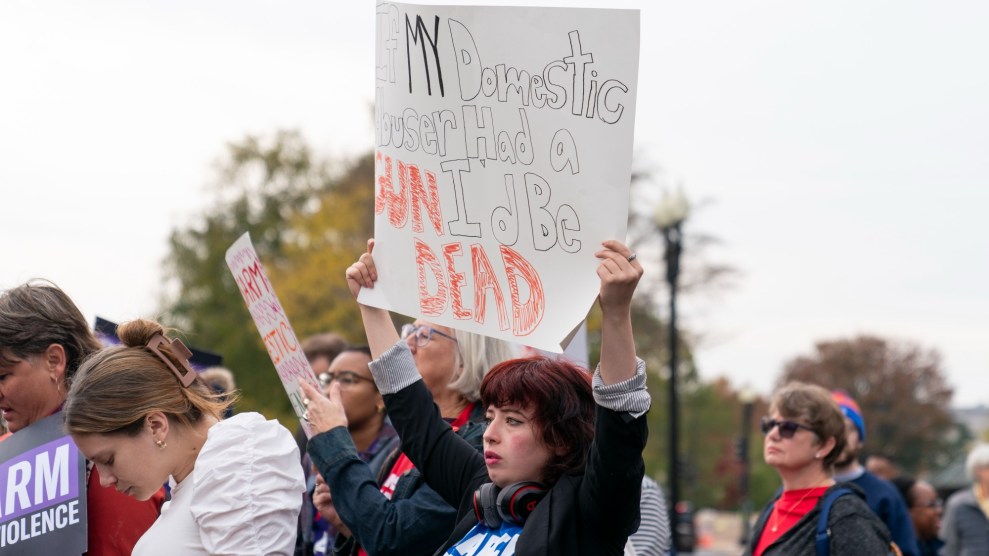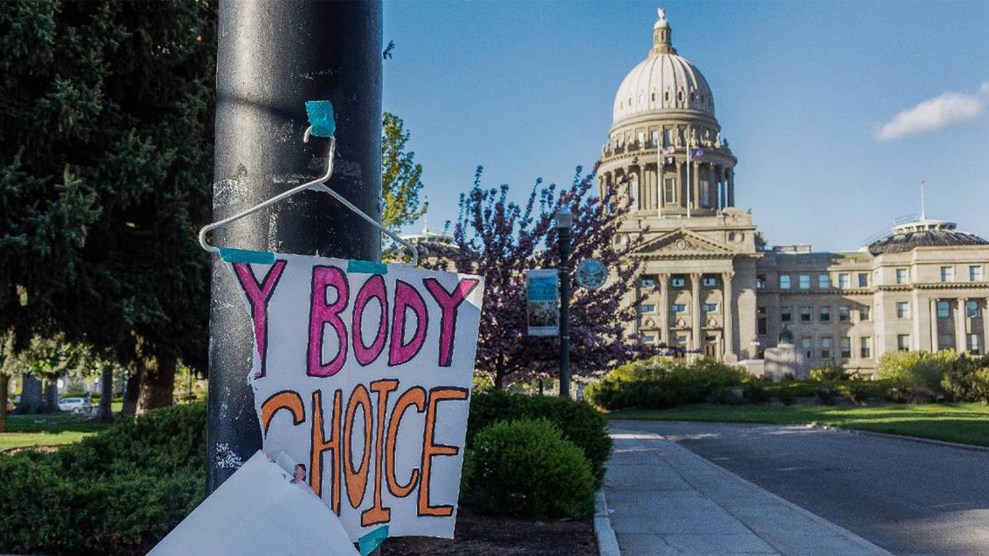
Mother Jones; Getty; Ian Hutchinson/Unsplash; Eric Ward/Unsplash
Every 16 hours in the US, a woman is gunned down in an act of domestic violence. Nearly 1 million American women have been shot or shot at by a current or former intimate partner; some 4.5 million have been threatened with a gun. Those appalling numbers would be even higher if Congress hadn’t enacted laws over the past 50 years prohibiting certain categories of abusers from possessing firearms, the leading cause of death in domestic violence homicides.
Now, in an 8 to 1 decision that is likely to have sweeping ramifications for other gun rights cases going forward, the Supreme Court has rejected an argument that could have gutted one of those protections for abused women and children, ruling that people who have domestic-violence restraining orders filed against them are banned from having guns. Read the opinion here.
The decision in US v. Rahimi, authored by Chief Justice John Roberts, upheld a 1994 federal law aimed at safeguarding victims of intimate partner violence for whom obtaining a protection order is both a vital step in breaking free from an abuser—and an act of empowerment that can increase an abuser’s rage. The court found that the prohibition on gun possession for people subject to restraining orders is consistent with the Second Amendment as interpreted by conservative justices in a landmark 2022 ruling.
“When an individual has been found by a court to pose a credible threat to the physical safety of another, that individual may be temporarily disarmed consistent with the Second Amendment,” Roberts wrote.
“Some courts have misunderstood the methodology of our recent Second Amendment cases,” Roberts added. “These precedents were not meant to suggest a law trapped in amber.” Otherwise, he wrote, the Second Amendment would only provide protection to “muskets and sabers.” In her concurring opinion, Justice Amy Coney Barrett noted, “Despite its unqualified text, the Second Amendment is not absolute.”
“Some courts have misunderstood the methodology of our recent Second Amendment cases. These precedents were not meant to suggest a law trapped in amber.”
The decision comes just a week after the court’s conservative supermajority threw out a ban on bump stocks, firearms accessories that for all intents and purposes, transform semi-automatic rifles into machine guns. Justice Clarence Thomas, who wrote the bump stock ruling, was the sole dissenter in the Rahimi case. His dissent contends that “Not a single historical regulation justifies the statute at issue,” adding, “in the interest of ensuring the Government can regulate one subset of society, today’s decision puts at risk the Second Amendment rights of many more.”
Today’s ruling comes at a time when intimate partner homicides have been soaring in the US—up 22 percent since 2018, according to a new analysis by the Brady Center to Prevent Gun Violence. As my Mother Jones and Reveal colleagues have reported, the increase in domestic violence gun deaths has been fueled by the pandemic and by red-state legislation that make it easier to purchase firearms, to carry them in public, and to claim self-defense even when the shooter is the aggressor. The toll is horrific—in addition to intimate partners, victims frequently include children, other family members, police officers, and bystanders.
A 2019 Mother Jones investigation found that misogyny, stalking of women, and domestic violence have factored into numerous mass shootings. But women are at the greatest risk: They are five times more likely to be killed in a domestic violence incident if the abuser owns a gun—and 21 times more likely to be murdered by a firearm in the US than women in other countries.
Public health researchers have understood the risks to abused women for decades, enacting a series of laws intended to make them safer. The Gun Control Act of 1968 makes it illegal for people convicted of a felony to possess a firearm. A quarter-century later, as part of the Violence Against Women Act, Congress barred people subject to family violence protection orders from having firearms. Two years after that, lawmakers expanded the federal gun restrictions to include some people convicted of domestic violence misdemeanors. Those laws are credited with significantly reducing intimate partner homicides starting in the mid-1990s. But about a decade ago, the number of such killings started to rise again. According to researchers, the increase has been driven exclusively by easier access to firearms—and by the failure of police, prosecutors, and courts to take guns away from people who are prohibited by law from possessing them.
At the center of today’s Supreme Court decision is a Texas man named Zackey Rahimi who epitomizes the type of toxic masculinity that my Mother Jones colleague Mark Follman has found to be a throughline in many acts of gun violence. In December 2019, Rahimi assaulted his then-girlfriend in a parking lot, dragged her by her hair into his car, smashed her head on the dashboard, and fired his gun at a bystander who tried to intervene. The girlfriend escaped and obtained a protective order barring Rahimi from having any contact with her or their young son for two years. The restraining order also suspended his handgun license and prohibited him from possessing a firearm under the 1994 law.
Rahimi violated the restraining order repeatedly over the next few months and faced state charges at least twice, only to be freed on bail. Federal authorities finally took action after he went on a two-month rampage in late 2020 and early 2021, terrorizing people in five separate incidents. According to the federal government’s petition to the Supreme Court, in one of these attacks, “after someone who had bought drugs from [Rahimi] ‘started talking trash’ on social media, he went to the man’s home and fired bullets into it using an AR-15 rifle.” In another incident, “Rahimi pulled out a gun and fired multiple shots in the air after a friend’s credit card was declined at a fast-food restaurant.”
A search of Rahimi’s home after the spree turned up a .45-caliber pistol, a .308-caliber rifle, pistol and rifle magazines, ammunition, about $20,000 in cash, and a copy of the restraining order. A federal grand jury indicted him on charges of illegally possessing a firearm, punishable at the time by up to 10 years in prison (now 15 years).
From the beginning, Rahimi’s lawyers argued that banning him from having a firearm violated his Second Amendment rights. But Rahimi ultimately pleaded guilty to the gun charge, receiving a six-year prison sentence. The ultra-conservative Fifth Circuit Court of Appeals upheld the conviction.
There his case might have ended. But in June 2022, in a sweeping ruling authored by Justice Clarence Thomas, the Supreme Court threw out a New York state law that required anyone who wanted a concealed handgun license to show a “special need” for self-protection. More fundamentally, the decision in New York State Rifle & Pistol Association v. Bruen upended the way gun-safety laws are evaluated under the Second Amendment. According to Thomas’s ruling, in order to pass constitutional muster, gun restrictions must be “consistent with the Nation’s historical tradition of firearm regulation.”
Rahimi’s case was reopened, and this time the Fifth Circuit lived up to its far-right reputation. In the 3-0 ruling in March 2023, Trump-appointed appeals court judge Cory T. Wilson conceded that preventing domestic abuse is a “laudable policy goal.” But the federal government’s logic about disarming “non-law-abiding people” went too far, he wrote. “Could speeders be stripped of their right to keep and bear arms?” he fretted. “Political nonconformists? People who do not recycle or drive an electric vehicle?”
That mind-boggling decision became one of the first Second Amendment cases to go before the Supreme Court since Bruen—and was widely seen as an opportunity for the justices to clarify Bruen’s controversial, and confusing, history-focused test.
The problem with applying Thomas’s analysis to domestic violence cases, many commentators pointed out, is that the “nation’s historical traditions” didn’t include protecting women from abusive men. To the contrary: Under Anglo-American common law, “a husband had a legal right to subject his wife to physical violence if she defied his authority,” the Brady Center pointed out in an amicus brief. “It was not the place of the state to intervene to prevent this violence.”
Even so, Solicitor General Elizabeth Prelogar told the Supreme Court in oral arguments last fall, “throughout our nation’s history, legislatures have disarmed those who have committed serious criminal conduct or whose access to guns poses a danger.” She also noted that, all too often, “the only difference between a battered woman and a dead woman is the presence of a gun.” Given the facts of Rahimi’s case, it was an argument that seemed to resonate with the majority of justices.
In his majority decision, Roberts said that early English and early American gun laws “confirm what common sense suggests: When an individual poses a clear threat of physical violence to another, the threatening individual may be disarmed.”
In a concurring opinion, Justice Sonia Sotomayor, joined by Justice Elena Kagan, reiterated her belief that Bruen was wrongly decided. She wrote that she “welcome[s]” the extent to which today’s ruling “clarifies Bruen’s historical inquiry” but added that she “remain[s] troubled by Bruen’s myopic focus on history and tradition, which fails to give full consideration to the real and present stakes of the problem facing our society today.”















